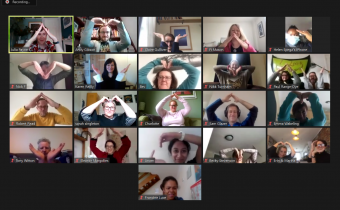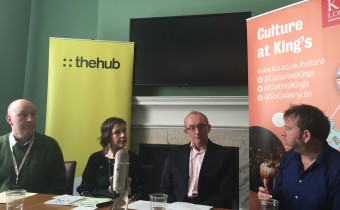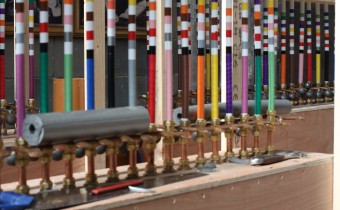New music has never had a golden age unless it’s right here, right now
There’s never been a better time to produce or promote music, says Tom Robinson as the Joining the Dots programme launches.
This is not, on the face of it, a great time to contemplate a career as a recording artist. Record sales are spiralling downwards, illegal file sharing is on the rise, and major record deals are few and far between. Even for those who do get signed, firework careers – up like a rocket, down like a stick – are commonplace.
And without question there’s far too much music in the world. Today’s newcomers face competition not only from their contemporaries but from the entire canon of postwar pop music. YouTube and Spotify make landmark hits from James Brown to James Blunt (and all points in between) available at the click of a button. It’s not, experts will tell you, like it was back in the golden age.
Well, excuse me for asking, but what golden age? Having been born in 1950, I remember my brother coming home with Bill Haley and Elvis Presley 78s to play on our family’s wind-up gramophone. The arrival of my teens coincided with that of the Beatles. The first Summer of Love, glam-rock and the wilder excesses of prog are still vivid memories. My own firework career as a pop star shot up alongside the Clash and the Sex Pistols, passing the Specials and Joy Division on its way down.
Musical movements came and went though the 1980s and 1990s. The rise of indie labels allowed diversity to flourish, but if the BBC didn’t play your record, most record fans would still never hear it. Radio 1 remained the primary gatekeeper of the nation’s airwaves and (with the honourable exception of John Peel) professional record pluggers were still the exclusive conduit to national airplay.
No. If it’s a golden age for recording artists you’re looking for, try the last seven or eight years and the rise of genuinely social media.
“The conversational many-to-many model means new artists with genuinely arresting talent no longer depend on money, insider contacts and the approval of gatekeepers to get heard. These days, all you need to be is good.”
When my first band started out in the 70s, high quality home recording was an unaffordable dream. Musicians had to go cap in hand to a publisher or record company to even get a demo, let alone a proper record.
Today you can make 24-bit master recordings with little more than a laptop and a pair of ears; a studio quality vocal mic now costs less than a hundred quid. You don’t even need to own these things yourself; they can be borrowed from mates, or shared with other songwriters. And if you go the whole hog and hire a full professional studio, the cost – in real terms – is just a fraction of what it was 30 or 40 years ago.
Back in my day, a hot new band might get an advance of £100,000 from their record company to cover recording costs on their first album. After manufacturing and distribution, the label would make around £4 per record, allocating around a pound of this to the band in royalties. So at 30,000 sales the label would make a profit of £20,000 while the band would still owe them £70,000. At 100,000 sales the band would break even, while the record company would have made £300,000. And who would own these recordings once they were paid for? Why, the record company of course. Some golden age.
Nowadays, websites like Kickstarter and Pledgemusic allow artists with a healthy following to raise five or even six figure sums to finance their recording costs. For the first time, it’s possible to independently make a record – to which you own the entire rights – completely free of debt. After fulfilling the pledges, every copy sold is sheer profit.
The 80s fad for music videos caused as many problems as it solved. Although there were almost no broadcast outlets for such videos in the UK, the industry wisdom was that every release needed to have one. Your single might cost £5,000 to record, but you’d then have to spend at least four times that to shoot a video that almost no-one at home would ever see. MTV Europe didn’t launch until 1989, and even then cable and satellite TV had dismally low penetration. In any case, unless you had powerful backing or a name director, your chances of making the MTV playlist were next to nonexistent.
In 2013 you can shoot your own high definition video on a mobile phone and edit it on the same laptop that recorded your single. You can upload it to YouTube and Vimeo where it’s instantly available to an audience of millions.
“This simple ability to publish video worldwide at no cost is a promotional opportunity artists in the previous five decades quite literally never dreamed of.”
If your music – or your visuals – happen to catch the public imagination, your view count can ratchet up into the millions within weeks. It happens all the time.
Of course, record companies, publishers and the broadcast media still wield enormous power, but they can’t exclusively choose which music the public will or won’t get to hear: the one-to-many model is no longer the only game in town. The continuing rise of Soundcloud, Twitter, Facebook – and YouTube itself – means that word of mouth now regularly bypasses the gatekeepers and leaves them playing catch-up.
Yes, there’s too much music and, yes, the competition is ferocious. It’s true that building an audience still involves a daunting amount of hard work. But for any artist with enough determination and talent, the message of hope bears repeating: today, for the first time in the history of the music business, all you need to be is good.
Tom Robinson is a musician and broadcaster – follow him on Twitter @freshnet. His blog marks the launch of Joining the Dots, a new funding and support programme for independent music
More from Tom in the Joining the Dots launch film.
This content is brought to you by Guardian Professional. (Photograph of Drenge by Sarah Lee)




